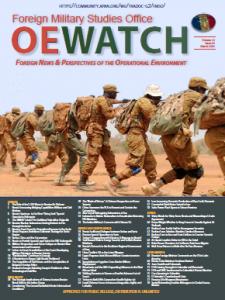 [Editor’s Note: Today’s post is excerpted from last month’s (March 2020) edition of the OE Watch, which in turn analyzes two articles from Jiefangjun Bao (the People’s Liberation Army [PLA] Daily), published earlier this year.
[Editor’s Note: Today’s post is excerpted from last month’s (March 2020) edition of the OE Watch, which in turn analyzes two articles from Jiefangjun Bao (the People’s Liberation Army [PLA] Daily), published earlier this year.
The … Read the rest

… Exploring the Operational Environment
 [Editor’s Note: Today’s post is excerpted from last month’s (March 2020) edition of the OE Watch, which in turn analyzes two articles from Jiefangjun Bao (the People’s Liberation Army [PLA] Daily), published earlier this year.
[Editor’s Note: Today’s post is excerpted from last month’s (March 2020) edition of the OE Watch, which in turn analyzes two articles from Jiefangjun Bao (the People’s Liberation Army [PLA] Daily), published earlier this year.
The … Read the rest
[Editor’s Note: Mad Scientist Laboratory is pleased to publish today’s post by guest bloggers Colonel Montgomery Erfourth and Dr. Aaron Bazin, addressing prospective patterns of emerging technology used in the 2020-2027 timeframe by Violent Extremist Organizations (VEOs), as … Read the rest
[Editor’s Note: The U.S. Army’s capstone unclassified document on the Operational Environment (OE) states:
“Russia can be considered our “pacing threat,” and will be our most capable potential foe for at least the first half of the Era of … Read the rest
[Editor’s Note: Mad Scientist Laboratory is pleased to publish today’s guest blog post by Mr. Alexander Temerev addressing the possible democratization and proliferation of nuclear weapons expertise, currently residing with only a handful of nation states (i.e., the … Read the rest
 [Editor’s Note: Mad Scientist would like to thank everyone who participated in the Mad Scientist Global Perspectives in the Operational Environment Virtual Conference on 29 January 2020 — from our co-hosts at the Army Futures Command (AFC) and the … Read the rest
[Editor’s Note: Mad Scientist would like to thank everyone who participated in the Mad Scientist Global Perspectives in the Operational Environment Virtual Conference on 29 January 2020 — from our co-hosts at the Army Futures Command (AFC) and the … Read the rest